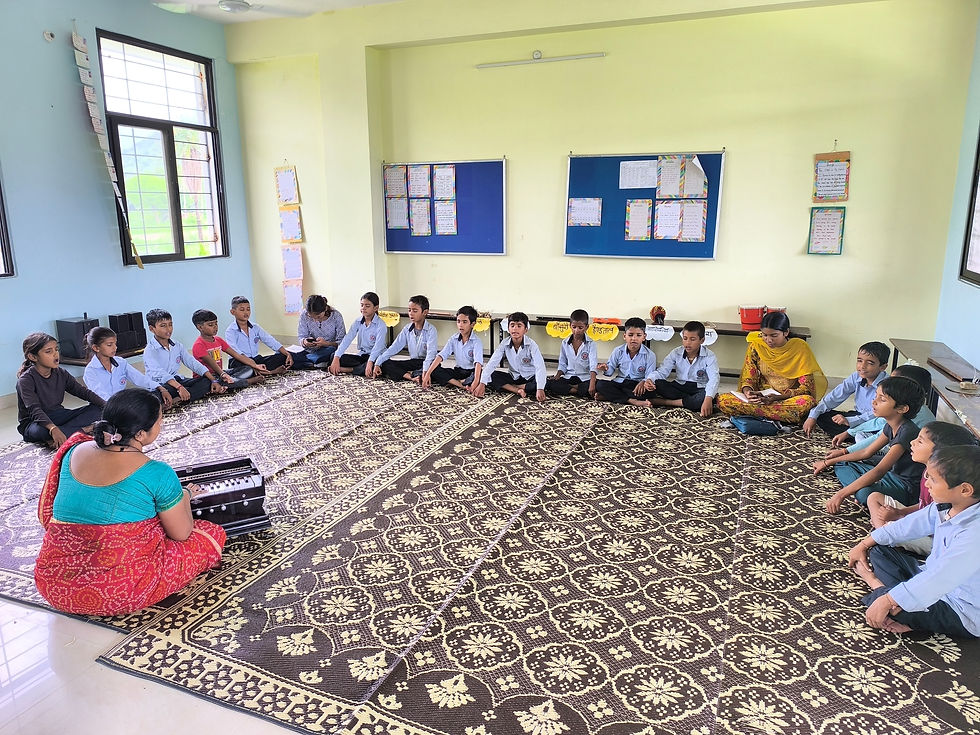Reimagining Education: Inside Bodh and Digantar
- Samanta
- Jul 29
- 3 min read
As part of our ongoing commitment to deepen the understanding of innovative and inclusive pedagogical practices, a group of educators from our organization recently undertook an insightful exposure visit to two well-regarded educational institutions in Jaipur: Bodh Shiksha Samiti and Digantar. The purpose of the visit was not only to observe how these institutions approach teaching and learning but also to engage in critical reflection on how such practices can be contextualized and integrated within our own work with children, especially in rural and underserved communities.

Day 1: Bodh Shiksha Samiti Learning Through Dialogue and Experience
Bodh Shiksha Samiti has long been recognized for its community-rooted and child-centric educational model. Upon arrival, our team was welcomed into a space that immediately reflected openness, mutual respect, and the celebration of local knowledge. We observed multi-grade classrooms where learning was happening organically through dialogue, exploration, and hands-on activities. The facilitators at Bodh did not position themselves as traditional instructors but rather as co-learners and guides. This fundamentally shifted the power dynamic in the classroom and empowered children to take ownership of their learning. What stood out was their commitment to building strong relationships with learners, allowing them to express their thoughts without fear of judgment. The use of local stories, folk songs, and experiential learning tools further anchored learning in the lived realities of the children. The team also engaged in conversations with teachers about their approach to curriculum planning, assessment without fear, and building critical consciousness among learners. One key insight was the emphasis on reflective practice—both for students and teachers as a tool for continuous learning and growth.


Day 2: Digantar Vidyalaya Reimagining Education as Liberation
Our second day took us to Digantar Vidyalaya, another pioneering institution in the space of alternative education. Founded on the principles of equity, freedom, and active learning, Digantar provided us with a model of education that breaks away from rigid structures and hierarchical roles. At Digantar, we observed a classroom culture grounded in democratic values where learners had the freedom to ask questions, explore multiple perspectives, and work at their own pace. Teachers functioned as facilitators, engaging children through inquiry-based learning, open-ended tasks, and peer collaboration. The physical learning environment itself reflected thoughtful design, from accessible learning materials and student-created displays to flexible seating arrangements that promoted group work and interaction. Emphasis was placed on conceptual understanding rather than rote memorization, especially in subjects like mathematics, science, and language. We also spent time exploring the institution’s teacher education model, which includes regular reflection meetings, pedagogical training, and a strong culture of peer feedback. The role of documentation in understanding children's learning journeys was particularly inspiring; educators kept detailed records, not for evaluation, but to inform and personalize their teaching strategies.

Reflections and Key Takeaways
This exposure visit was a deeply enriching experience for our educators. It provided a rare opportunity to see theory translated into grounded, community-responsive practice. Some key takeaways were included.
Pedagogy of Freedom: Both institutions emphasize learner autonomy, respect for children's voices, and education as a means of personal and social liberation.
Role of Teachers as Facilitators: Moving away from instructive teaching to a facilitative, inquiry-led model where teachers guide rather than dictate learning.
Learning Environment: Creating spaces that are emotionally safe, intellectually stimulating, and reflective of children's realities, from wall displays to language use.
Community Engagement: The integration of local culture, languages, and community knowledge strengthens both learning and identity.
By Danish
Program Manager (WST- QuEST)










Comments